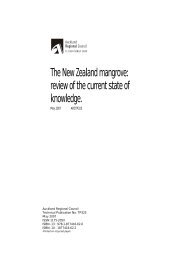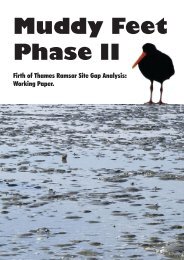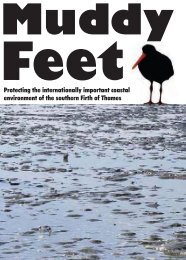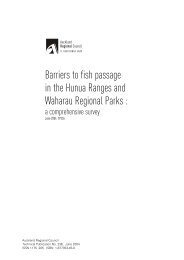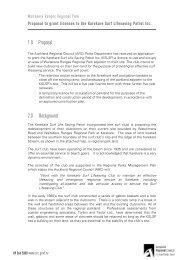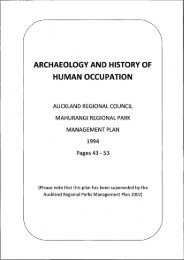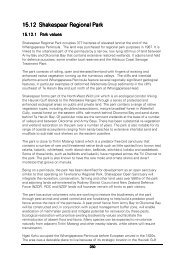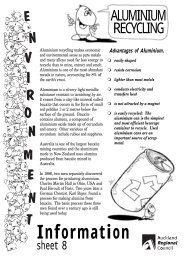MUDDY FEET - Auckland Regional Council
MUDDY FEET - Auckland Regional Council
MUDDY FEET - Auckland Regional Council
Create successful ePaper yourself
Turn your PDF publications into a flip-book with our unique Google optimized e-Paper software.
26<br />
• Approaches to Franklin District <strong>Council</strong> regarding the preservation of roadside<br />
colonies from verge maintenance activities. [Note: Waitakere City <strong>Council</strong> has<br />
introduced measures to protect its endemic roadside Hebe bishopiana.]<br />
• Conservation measures and possible covenants on Thompson’s Bush.<br />
• Further propagation of this species. Work is currently underway at Unitec.<br />
3.6 Exotic invaders – Adventive plant species<br />
3.6.1 Spartina<br />
The estuarine grasses of the genus Spartina are vigorous invaders of coastal mangrove and<br />
salt marsh, estuarine areas and mudflats, rapidly colonising suitable bare ground. They are<br />
tolerant of immersion in saltwater.<br />
Three taxonomic entities are possible, Spartina anglica, S. alterniflora and S. x townsendii.<br />
Of these, only S. anglica has been identified from the Firth of Thames, though this area is<br />
within the known range of S. alterniflora, (Partridge 1987). The <strong>Auckland</strong> and Waikato<br />
<strong>Regional</strong> <strong>Council</strong>s have the responsibility for control of Spartina and other weeds in the<br />
Ramsar Site (in accordance with lines of jurisdiction).<br />
Spartina anglica can form dense stands. This grass has vigorously growing rhizomes and<br />
roots that form a dense mat near the surface of the mud or sand. Anchor roots penetrating a<br />
metre or more down into the mud secure the plants, which can grow to more than a metre<br />
high. This species spreads both by seed and by pieces of the rhizome breaking off the parent.<br />
Distribution.<br />
Spartina anglica, a native of Britain, was deliberately introduced to New Zealand in the<br />
1920s to stabilise mudflats and provide food for stock. It is now found in coastal regions<br />
throughout much of New Zealand (Partridge 1987). Within the Firth of Thames it is found in<br />
most of the mudflat areas and estuaries of the Coromandel Peninsula and along the Miranda-<br />
Kaiaua Coast. Nineteen sites were identified in the mangrove zone from the Waihou to the<br />
Waitakaruru River during a 2000 aerial survey (P. Thomson, personal communication 2000).<br />
Some of the Spartina patches covered areas of nearly one hectare. Much of the Spartina was<br />
sprayed and eliminated by late 2004, but there were still numerous small patches of it<br />
remaining in difficult to access areas (S. Clark, personal communication 2004).<br />
Significance.<br />
Spartina prefers deep, soft fertile mud with a sandy loam texture, (Environment Waikato<br />
1998). The dense mats of Spartina bind the mudflat and help to trap sediment. The vigorous<br />
growth habit, which can outgrow most of the native reeds and other plants on the mudflat<br />
edge, result in colonies extending over these flats. The plants trap silt, thereby altering the<br />
conditions for shellfish, particularly the cockle, Austrovenus stutchburyi. Some cockle beds<br />
have been wiped out by Spartina invasions (Department of Conservation 1998).<br />
Considerable areas may be colonized. Simpson (1995) reports on one such invasion in<br />
Victoria, Australia: “In the 1980s the mudflats off Nolans Bluff, situated on the landward side<br />
of the Inlet, were a prime habitat for migratory waders, significant both in numbers and<br />
diversity of species reported. Today, completely colonized by Spartina, the area has been<br />
deserted by waders, to the extent that Nolans Bluff is no longer included as a count<br />
location…”<br />
EcoQuest Education Foundation EQRS/1 12/04



